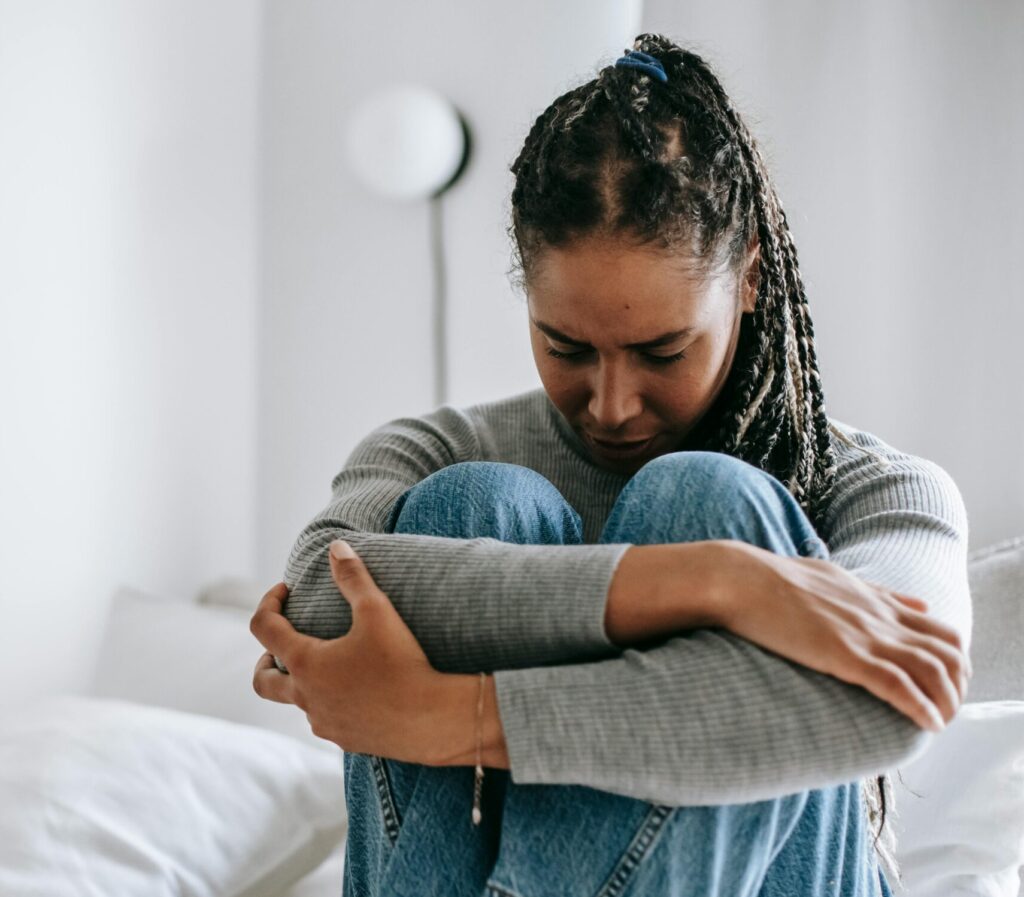Disclaimer: Not everyone who goes through menopause identifies as a woman and not all people who identify as women go through menopause. At Jayla, our core audience is people who identify as women, so we primarily use the word “women.” However, we’re working on specific content for people going through menopause who might not identify women. Inclusivity is a key value of ours, so bear with us!
Your 40s were supposed to come with wisdom—not weird bleeding patterns, pelvic pressure, and hot flashes in meetings. But here you are, trying to figure out what on earth is going on with your body.
If that sounds familiar, you’re in the right place.
This guide is for every woman navigating the double whammy of perimenopause and fibroids– often without clear answers, and far too often without being taken seriously.
What (TF) Is Happening to My Body?
Perimenopause is the transition to menopause that is characterized by hormonal fluctuations and symptoms such as (but definitely not limited to):
- Irregular periods
- Hot flashes and night sweats
- Mood swings
- Dry everything (skin, hair, nails…)
- Brain fog
Perimenopause can start as early as your late 30s but tends to hit hardest in your 40s. And because it doesn’t come with a clear start date, it’s easy to mistake it for “just stress.” (1)
For Black women, perimenopause can often hit harder. Not only does our perimenopause often start younger, but our symptoms tend to be more severe, including of course… fibroids! (2, 3)
The Fibroid Factor
Fibroids are non-cancerous growths in or around the uterus that can be as small as peas or as large as melons (I know – sounds scary). (4) Up to 80% of Black women will develop them by age 50 – compared to 70% of White women. (5)
On top of that, Black women tend to get fibroids that:
- Start earlier
- Grow larger
- Cause more severe symptoms
Why are Black women more affected by fibroids?
The research points to a mix of factors including genetics, inflammation, hormone sensitivity, and systemic stress. And yes—racism and bias in healthcare (unsurprisingly) play a role, influencing everything from diagnosis to treatment options. (5, 6) This is consistent with the concept of weathering: the idea that chronic exposure to stress, particularly racism, can wear down the body over time and contribute to higher rates of conditions like fibroids. (7)
Still, the exact cause of fibroids isn’t fully understood. And—frustratingly but not shockingly—more research is needed. Like much of women’s health (especially when it comes to Black women), fibroids remain under-researched and underfunded, leaving too many questions unanswered and too many women unsupported.(8)
How can I tell if I have fibroids?
Fibroids can be tricky—some people have no symptoms at all, while others experience a range of disruptive symptoms.
Symptoms to watch for include:
- Heavy periods (we’re talking changing pads or tampons hourly)
- Pelvic pressure or pain
- Bloating that won’t quit
- Frequent peeing or feeling like you can't fully empty your bladder
- Pain during sex
If something feels off, trust your gut and talk to a Jayla healthcare provider. A pelvic exam or ultrasound can usually confirm whether or not you have fibroids.
When Perimenopause and Fibroids Join Forces
We hate to be the one to break it to you: perimenopause can make fibroids worse before things eventually settle after menopause.If perimenopause is the opening act, fibroids often storm the stage for an encore you didn’t ask for.
Unfortunately, this hormonal transition can make existing fibroids grow or cause new ones to pop up—especially in the earlier stages of perimenopause, when estrogen levels can spike unpredictably before eventually declining (hormonal decline is not linear during perimenopause).
Here’s why: fibroids feed on estrogen. So when your body’s hormone levels start fluctuating (hello, perimenopause), fibroids often take that as an invitation to grow. Cue heavier bleeding, more cramps, and feeling like you constantly need to pee.
On top of that, the symptoms of perimenopause—like fatigue, mood swings, and poor sleep—can make fibroid symptoms feel even more intense. The bloating, the pressure, the bathroom runs… all add up.
We’re not going to say, “Don’t worry, after menopause fibroids will go away,” because on average, Black women experience menopausal symptoms for 10 years. You don’t need to struggle for an entire decade. (9)
There are ways to manage both perimenopause and fibroids, and that’s what we’ll get into next.
Managing fibroids and perimenopause – the care you deserve
Too many Black women get dismissed in healthcare settings, particularly for symptoms more common in Black women. (10) At Jayla, we believe your care should be holistic, culturally competent, and built around what matters to you.
That means:
– Physical care: A provider who listens, takes your symptoms seriously, and helps you navigate options—from fibroid management to hormone therapy. Jayla’s hormone testing kits are designed to give you clarity, with support from perimenopause-trained clinicians who work with you to make sense of what’s happening in your body.
– Mental health: Therapy or counseling to help manage the emotional toll—because hormonal changes, heavy bleeding, and health anxiety can be overwhelming. You don’t have to carry that alone.
– Community: Real talk with other women going through it too. You’re not imagining it, and you’re not alone.
– Nutrition & lifestyle: Anti-inflammatory foods, stress management, movement, hydration.
There’s no shame in choosing the care that works for you—whether it’s medical, spiritual, holistic, or a little bit of everything. Jayla is here to help you figure it out, piece by piece, with clinicians who get it and care plans that don’t treat you like an afterthought.
How can I support myself through fibroids and perimenopause?
In the meantime, here’s how you can support yourself:
If you’re uncertain, navigating next steps, or on the fence about ordering your Jayla hormone test kit (you won’t regret it), these small but practical actions can help you feel a bit more in control:
Certain cancer treatments, especially those targeting the pelvic area, can damage the ovaries, leading to early perimenopause. (5) The surgical removal of our ovaries (called a bilateral oophorectomy) causes immediate menopause, regardless of age. (6)
– Track what’s going on. Keep a simple record of your symptoms—period changes, pain, energy levels, mood swings. It’ll help you spot patterns and give your doctor better context.
– Prioritize rest. Fatigue during perimenopause and fibroids is real. If you’re tired, it’s not laziness—it’s your body asking for recovery time.
– Eat foods that reduce inflammation. Think leafy greens, berries, oily fish, turmeric, and less ultra-processed stuff. And don’t think that just means following the Mediterranean diet. Many cultural foods—from dal to collard greens to kimchi—can support lower inflammation, too. No need to overhaul everything—small swaps count.
Relief through Nutrition: Read about how what you eat can help manage your symptoms.
– Move your body gently. Walking, stretching, yoga—whatever feels manageable. It can help ease bloating, mood swings, and stress.
– Stay hydrated. Especially if you’re bleeding heavily, water and iron-rich foods are your friends.
– Set boundaries. Whether it’s saying no to plans or taking breaks at work, your energy isn’t unlimited. Protect it.
– Talk to someone. Whether it’s a friend, therapist, or support group, don’t keep it all in your head.
You don’t need to do everything at once. Just start where you are. And remember: you’re not falling apart, you’re evolving. Don’t listen to anyone who tells you anything different.
Further questions
If our blog piece didn’t answer all your questions, perhaps these will:
Do fibroids grow faster during perimenopause?
In a word: sometimes. Perimenopause is a hormonal rollercoaster, not a gentle slope. Estrogen levels don’t just quietly drop; they spike, dip, and ricochet. Fibroids grow with estrogen, so during those estrogen surges, fibroids can absolutely grow faster.
Are fibroids common during perimenopause?
Very. Fibroids are already super common (especially among Black women), and perimenopause doesn’t hit pause on that. If anything, it can shine a spotlight on fibroids you didn’t even know you had. You’re not imagining it—those heavier periods, pelvic pressure, and “why do I feel so bloated all the time?” moments? They might be fibroids making their presence known during this transitional time.
Can perimenopause cause fibroids?
Perimenopause doesn’t exactly cause fibroids from scratch—but it can definitely stir the pot. If fibroids were lying low, perimenopause might just give them a reason to act up. That’s because your hormone levels are all over the place, and fibroids are very responsive to those shifts. So while perimenopause isn’t the root cause, it’s definitely a powerful accelerant.
Do fibroids get worse during perimenopause?
Unfortunately, yes—for many people. The double whammy of perimenopause symptoms plus fibroids is no joke. You might feel like you’re dealing with a whole new level of pain, pressure, and fatigue. And when you’re bleeding heavier and sleeping worse and navigating mood swings? It’s a lot. But there are ways to manage it. Jayla offers care that meets you where you are.
References
1. North American Menopause Society (NAMS), 2022. What is perimenopause? [online] Available at: https://www.menopause.org/for-women [Accessed 9 June 2025].
2. Gold, E.B. et al. (2001) Factors associated with age at Natural Menopause in a multiethnic sample of Midlife Women, OUP Academic. Available at: https://academic.oup.com/aje/article/153/9/865/124589?login=false (Accessed: 21 June 2024).
3. Thurston, R.C. et al. (2008) Beyond frequency: Who is most bothered by vasomotor symptoms?, Menopause (New York, N.Y.). Available at: https://www.ncbi.nlm.nih.gov/pmc/articles/PMC2866103/ (Accessed: 21 June 2024).
4. Stewart, E.A., Cookson, C.L., Gandolfo, R.A. and Schulze-Rath, R., 2017. Uterine fibroids. The Lancet, 393(10167), pp.182–197. doi:10.1016/S0140-6736(17)31886-6
5. Baird, D.D., Dunson, D.B., Hill, M.C., Cousins, D. and Schectman, J.M., 2003. High cumulative incidence of uterine leiomyoma in black and white women: ultrasound evidence. American Journal of Obstetrics and Gynecology, 188(1), pp.100–107. doi:10.1067/mob.2003.99
6. Laughlin-Tommaso, S.K., 2020. Fibroid-related quality of life and racial disparities. Fertility and Sterility, 113(3), pp.511–512. doi:10.1016/j.fertnstert.2019.12.026
7. Geronimus, A.T., 1992. The weathering hypothesis and the health of African-American women and infants: evidence and speculations. Ethnicity & Disease, 2(3), pp.207–221.
8. Hackett, J., Onakpoya, I., Kaye, R., Harper, G., Dobson, C., Eskinazi, L., Oteng-Ntim, E. and Arambage, K., 2024. Why are Black women at greater risk of symptomatic uterine fibroids? A qualitative investigation of women’s experiences. BMJ Open, 14(8), e085622. https://doi.org/10.1136/bmjopen-2024-085622
9. Paramsothy, P. et al. (2017) Duration of the menopausal transition is longer in women with young age at onset: The multiethnic study of Women’s health across the nation, Menopause (New York, N.Y.). Available at: https://www.ncbi.nlm.nih.gov/pmc/articles/PMC5266650/ (Accessed: 21 June 2024).
10. Alson, J.G., Robinson, W.R. and Pittman, L., 2019. Disparities in health care: the intersection of race, gender and socioeconomic status. Health Equity, 3(1), pp.393–402. doi:10.1089/heq.2019.0044



